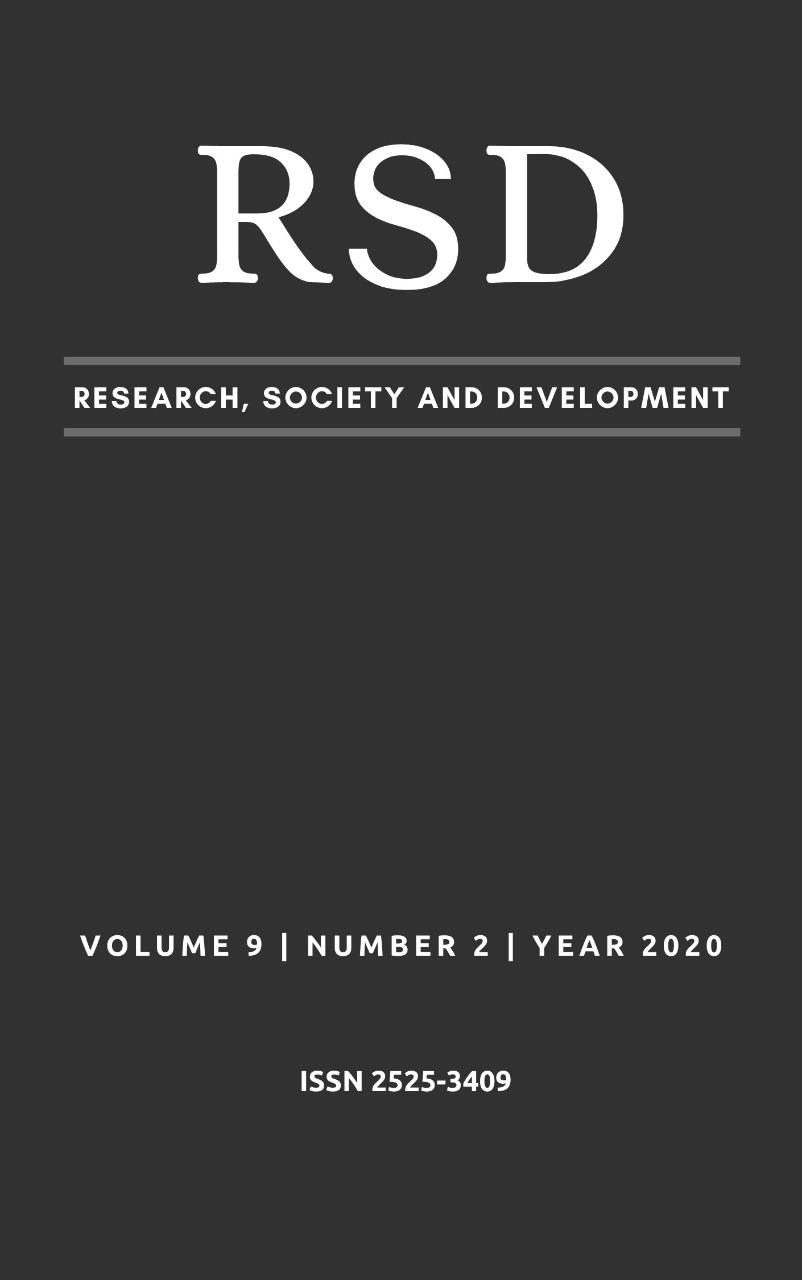Produção de álcool de batata-doce variando as condições de fermentação e hidrólise
DOI:
https://doi.org/10.33448/rsd-v9i2.2201Palavras-chave:
Ipomoea batatas L., Saccharomyces cerevisiae, Hidrólise, Bioetanol.Resumo
O bioetanol é um combustível renovável como fonte alternativa de energia de importância mundial. O presente estudo teve como objetivo avaliar a produção de álcool a partir de batata-doce, sob diferentes condições de reação para fermentação e hidrólise. Um genótipo foi selecionado para obtenção de farinha seca e processado por hidrólise ácida e hidrólise enzimática com α-amilase e amiloglucosidase. O experimento foi realizado em delineamento de blocos completamente casualizados com três repetições de pontos centrais, combinadas com a metodologia da superfície de resposta. As variáveis foram pH, temperatura e tempo de fermentação. O teor de álcool foi determinado por destilação com subsequente análise espectrofotométrica. As matérias-primas foram caracterizadas quanto à umidade, açúcares redutores e amido, obtendo-se 4,13%, 4,04% e 71,80%, respectivamente. A hidrólise ácida mostrou maiores porcentagens de álcool nas amostras destiladas. Os maiores valores de hidrólise ácida e hidrólise enzimática nas fermentações foram 26,42% e 25,04%, respectivamente, realizados a pH 5,0 e 36 ° C por 5 dias. O tempo de fermentação foi a variável mais importante, com valores mais altos e significativos para os dois tipos de hidrólise. A hidrólise ácida apresentou maior potencial de produção alcoólica do que a hidrólise enzimática na fermentação da batata-doce.
Referências
Alves, R. M. V.; Ito, D.; Carvalho, J. L. V.; Melo, W. F. & Godoy, R. L. O. (2012). Estabilidade de farinha de batata-doce biofortificada. Brazilian Journal of Food Technology. Campinas, 15, 59-71. doi: 10.1590/S1981-67232012000100007.
Agência Nacional de Vigilância Sanitária. (2005). Resolução – RDC n° 263, de 17 de outubro de 2005. Regulamento técnico para produtos de cereais, amidos, farinhas e farelos.
Amit, S. K.; Uddin, M.; Rahman, R.; Islan, S. M. R. & Khan, M. S. (2017). A review on mechanisms and commercial aspects of food preservation and processing. Agriculture & Food Security. 6 (51). doi: 10.1186/s40066-017-0130-8.
Camargo, L. K. P.; Mógor, A. F.; Resende, J. T. V. & Silva, P. R. (2013). Establishment and molecular characterization of a sweet potato germplasm bank of the highlands of Paraná State, Brazil. Genetics and Molecular Research. 12 (4), 5574-5588. doi: 10.4238/2013.November.18.7.
Canilha, L.; Chandel, T. S. S. M.; Antunes, F. A. F.; Freitas, W. L. C. & Felipe, M. G. A. (2012). Bioconversion of Sugarcane Biomass into Ethanol: an overview about composition, pretreatment methods, detoxification of hydrolysates, enzymatic saccharification and ethanol fermentation. Journal of Biomedicine and Biotechnology. 15 p. doi: 10.1155/2012/989572.
Cantos-Lopes, A.; Resende, J. T. V. de; Machado, J.; Guerra, E. P. & Resende, N. V. (2018). Alcohol production from sweet potato (Ipomoea batatas (L.) Lam.) genotypes in fermentative medium. Acta Agronômica. 67, 231-237. doi: 10.15446/acag.v67n2.65321.
Food and Agriculture Organization of the United Nations. Faosta, Sweet Potatoes, Production Quantity (Tons) - for All Countries. (2017). Retrieved from: http://www.fao.org/faostat/en/#search/Sweet%20potatoes.
Ferrari, M. D.; Guigou, M. & Lareo, C. (2013). Energy consumption evaluation of fuel bioethanol production from sweet potato. Bioresource Technology. 136, 377–384. doi: 10.1016/j.biortech.2013.03.045.
Instituto Adolfo Lutz. (2005). Brasil. Ministério da Saúde. Agência Nacional de Vigilância Sanitária. Métodos físico-químicos para análise de alimentos. Brasília: Ministério da Saúde.
Pavlak, M. C. M; Abre-Lima, T. L.; Carreiro, S. C. & Paulillo, S. C. L. (2011). Estudo da fermentação do hidrolisado de batata-doce utilizando diferentes linhagens de Saccharomyces cerevisiae. Química Nova. 34 (1), 82-86. doi: 10.1590/S0100-40422011000100016.
Pereira, C. R.; Resende, J. T. V.; Guerra, E. P.; Lima, V. A.; Martins, M. D. & Knob, A. (2017). Enzymatic conversion of sweet potato granular starch into fermentable sugars: Feasibility of sweet potato pell as alternative substrate for a-amylase production. Biocatalysis and Agricultural Biotechnology. 11, 231-238. doi: 10.1016/j.bcab.2017.07.011.
Schweinberger, C. M.; Trierweiler, J. O. & Trierweiler, L. F. (2019). A simple equation for toral reducing sugars (TRS) estimation on sweet potato and ethanol yield potential. Brazilian Journal of Chemical Engineering. 36 (01), 33 – 41.
Silva, J. O. V.; Almeida, M. F.; Alvim-Ferraz, M. da C. & Dias, J. M. (2018). Integrated production of biodiesel and bioethanol from sweet potato. Renewable Energy. 124, 114-120. doi: 10.1016/j.renene.2017.07.052
Srichuwong, S.; Orikasa, T.; Matsuki, J.; Shiina, T.; Kobayashi, T. & Tokuyasu, K. (2012). Sweet potato having a low temperature-gelatinizing starch as a promising feedstock for bioethanol production. Biomass and Bioenergy. 39, 120-127. doi: 10.1016/j.biombioe.2011.12.023.
Tian, S., Zhao, R. & Zhao, J. (2018). Production of bioethanol from sweet potato tubers with different storage times. Bio Resources. 13(3), 4795-4806.
Woiceienchowski, A. L.; Nitsche, S.; Pandey, A. & Soccol, C. R. (2002). Acid and enzymatic hydrolysis to recover reducing sugars from cassava bagasse: an economic study. Curitiba: Brazilian Archives of Biology and Technology. 45 (3), 393-400. doi: 10.1590/S1516-89132002000300018.
Downloads
Publicado
Edição
Seção
Licença
Autores que publicam nesta revista concordam com os seguintes termos:
1) Autores mantém os direitos autorais e concedem à revista o direito de primeira publicação, com o trabalho simultaneamente licenciado sob a Licença Creative Commons Attribution que permite o compartilhamento do trabalho com reconhecimento da autoria e publicação inicial nesta revista.
2) Autores têm autorização para assumir contratos adicionais separadamente, para distribuição não-exclusiva da versão do trabalho publicada nesta revista (ex.: publicar em repositório institucional ou como capítulo de livro), com reconhecimento de autoria e publicação inicial nesta revista.
3) Autores têm permissão e são estimulados a publicar e distribuir seu trabalho online (ex.: em repositórios institucionais ou na sua página pessoal) a qualquer ponto antes ou durante o processo editorial, já que isso pode gerar alterações produtivas, bem como aumentar o impacto e a citação do trabalho publicado.


